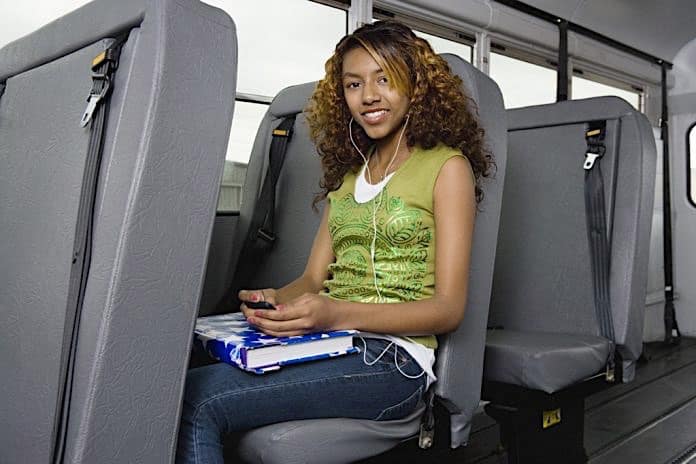Even as National School Bus Safety Week kicked off, a new report confirms what the student transportation industry and traffic safety experts have known to be true for years: Motor vehicle crashes are the No. 1 cause of teen fatalities.
Consequently, school buses are safer transportation modes for getting teenagers — and all students — to and from school. Teen Driver Safety Week happens to coincide with School Bus Safety Week, even as the numbers of teenagers who ride the school bus continue to drop. There are various reasons for this, including reduced routes or school districts eliminating busing to and from high schools altogether, because of budget cuts. Teens also strive for more independence, which can mean wanting to drive themselves or ride with friends.
The General Motors Foundation and Safe Kids Worldwide partnered on a recent survey of 1,000 teens aged 13 to 19 and found that there are about 2,500 teen fatalities in motor vehicle crashes each year. Half of these deaths are attributed to not wearing a seat belt.
“No one starts their day anticipating that they’re going to get into a car crash. But we all know that it only takes one time to be riding in a vehicle without buckling up for a life to be changed forever,” said Kate Carr, president and CEO of Safe Kids Worldwide. “This survey illustrates that we must be even more vigilant in our efforts to reach teens with messages that will resonate so they understand the importance of buckling up every ride, every time.”
Safe Kids Worldwide Tips for Families
1. Buckle up on every ride, every time. This is
important for everyone, both drivers and passengers.
2. Talk to teens and kids about ways to speak up if
any driver of any age isn’t driving safely.
3. Be a role model in all your driving habits.
Meanwhile, 49 percent of teens who responded said they feel concerned for their safety when they ride with another teen driver. Interestingly, 31 percent said they have felt unsafe even when a parent is driving. But only four in 10 teens asked the driver to stop, and Safe Kids reported that nearly the same number said or did nothing.
“It can be uncomfortable for anyone to speak up when they feel unsafe riding in a vehicle, and perhaps even more so for teens riding with their peers,” said Mike Robinson, GM vice president of sustainability and global regulatory affairs and board member for both Safe Kids Worldwide and the GM Foundation (the latter granted $2 million for the study). “The results of this research further underscore the importance of reaching teens with the life-saving messages to buckle up during every ride and to speak up when they don’t feel secure.”
While a Safe Kids representative declined comment for this story because school bus safety “is not one of Safe Kids’ focus areas,” student transportation industry leaders told STN they found it ironic that Teen Drive Safety Week and School Bus Safety Week overlap.
“What a contrast this confluence of safety weeks illustrates,” added Charlie Hood, executive director of NASDPTS. “The former is designed to bring attention to the dangers posed by motor vehicle crashes involving teen drivers and their passengers. The latter is intended to celebrate the incredible safety provided to school bus passengers, including teens, by school buses and school bus operators. At their core, both aim to ensure and improve safety.”
Mike Martin, executive director of the National Association for Pupil Transportation, agreed and said he also found this year’s overlap of safety campaigns “interesting”
“Especially because the teen driver safety campaign acknowledges that teens aren’t ready to have the same level of driving responsibility as older adults, and points out that ‘teen drivers speed, they make mistakes, and they get distracted easily — especially if their friends are in the car’ and therefore have more crashes,” Martin said. “The campaign encourages parents to ‘get the facts about teen driving and share some of the grim statistics with your teen,’ which is great advice.”
Martin recommended teen driver safety advocates include school bus safety facts in their campaign. First of all, he said school buses are designed to be safer than passenger vehicles in avoiding crashes and preventing injury. Second, school buses are the safest mode of transportation for getting children back and forth to school.
Tim Flood, president of the National School Transportation Association, added, “Safety is our top concern. We know that children are 23 times safer on a school bus than in their parent’s vehicle and 58 times safer on a school bus than in a car driven by a teenage driver. We commend any effort to increase the safety of teenage drivers and hope the focus that Teen Driver Safety Week brings can only assist in that effort.”
Added Hood: “We should use the occasion of National School Bus Safety Week to encourage the availability and use of school buses as the safest, most environmentally friendly and most accessible form of school transportation.”


















